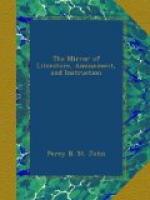OLD COVENT GARDEN.
[Illustration: Old Covent Garden. ]
The notoriety of Covent Garden is of too multifarious a description to render the above illustration uninteresting to either of our readers. It is copied from one of Hollar’s prints, and represents the Garden about the time of Charles ii., before its area had been polluted with filth and vegetable odours.
The spot was originally the garden belonging to the abbot of Westminster, which extended to St. Martin’s church, was called the Convent Garden, and may be distinctly traced in Ralph Agar’s View of London, bearing date about 1570. It was granted, after the dissolution, by Edward VI. first to the protector Somerset, on whose attainder, in 1582, it passed into the Bedford family. About the year 1634, Francis, Earl of Bedford, began to clear away the old buildings, and to form the present handsome square. Its execution was confided to Inigo Jones, but unfortunately, only the north, and part of the east side, was completed; for, had the piazza been continued on the other this would have been one of the noblest quadrangles in the metropolis. Previously to the erection of the present mass of huts and sheds, the area was neatly gravelled, had a handsome dial in the centre, and was railed in on all sides, at the distance of sixty feet from the buildings. The south side was bounded by the garden wall of Bedford-House, the town house of the noble family of that name; and along this wall only were the market booths. But the mansion has long given way to Little Bedford-street.
The most striking object in the engraving is, however, the original church of St. Paul, as built by Inigo Jones, connected with which is the following anecdote:—When the Earl of Bedford sent for Jones, in 1640, he told him he wanted a chapel for the parishioners of Covent Garden; but added, he would not go to any considerable expense. “In short,” said he, “I would not have it much better than a barn.”—“Well, then,” replied Jones, “you shall have the handsomest barn in England.” The ceiling was very beautifully painted by Edward Pierce, sen. a pupil of Vandyke. In 1795, the church was accidentally destroyed by fire, but it was rebuilt by Mr. Hardwick, in imitation of the original design.
In a note at page 236 of vol. x. of the mirror, we adverted to the disgraceful state of Covent Garden Market, which of late years has been little better than a public nuisance. The broom of reform at length promises to cleanse this Augean area; and a new market is in the course of erection. The design, it will be recollected, was in this year’s Exhibition at Somerset House, and in an early Number we may probably give a view of the Elevation.




